Facebook ads are the darling of the marketing world. Even the smallest companies are using them because they’re so effective at reaching people who would otherwise be out of reach.
If you know how to manage mortgage Facebook ads, they work even better than a lot of more traditional marketing. But you can’t just throw a little money around and hope something sticks. That’s a sure recipe for frustration.
In this comprehensive guide to mortgage Facebook ads, we’ll give you everything you need to run a successful campaign including who to target, what to target them with, how to set the whole thing up, and how to measure success.
Why Mortgage Facebook Ads?
Whether you want to get new leads or work on your referral marketing, Facebook ads should be a vital part of your strategy—here’s why.
Facebook Has a Lot of Users
According to Facebook, two billion people use the platform every single month. And this number continues to steadily rise. You can’t come close to this kind of reach with any other marketing options.
People Spend a LOT of Time on Facebook
One of every five minutes spent on the internet is on Facebook or the Facebook-owned Instagram. The average person will spend an astonishing two hours on social media sites every single day.
Put another way, people spend more time on social media than they do eating, grooming, socializing, or doing laundry. With so many people in one place every day, Facebook makes it easy to get their attention.
Facebook Ads Are Targeted
Facebook has all kinds of data on users (data that the users have freely given), so you can narrow down your audience with some powerful tools (more on that later).
If you know that certain types of people are likely to become your clients, you can target those people and exclude all the others. This ensures that your money goes to people who are most likely to give you a return on your investment.
In other words, you don’t want to try to sell a refinance to renters. But you may want to try to sell a refinance to middle-aged homeowners in your state.
Facebook Ads Are a Deal
Facebook ads are an inexpensive way to reach people, which makes them perfect for businesses with a small marketing budget. You can reach goals you’d never be able to otherwise.
As an example, as little as $10 a day can help you reach your audience. Compare that to a single click on Google AdWords costing upwards of $60 for mortgage keywords, and you can see why it’s such a deal.
You can set your ad budget in several different ways, so you’ll never spend more than you want. You have complete control over your daily budget and your bid based on your goals.
Facebook Ads Work for More than Leads
Facebook ads work well for getting new leads. But they also work well for building relationships with your current database and getting repeat and referral business.
Facebook Ads Aren’t Google AdWords
Google AdWords are active or demand-based ads. When you create an ad with Google AdWords, you’re giving people what they’ve already indicated that they’re interested in.
If someone types in, “Colorado mortgage refinance,” they’re looking for a loan officer in Colorado to help them refinance right now. People who see Google AdWords are actively looking for information.
But people don’t go on Facebook actively thinking about refinancing. They’re there to see pictures of their best friend’s trip to Australia or their mom’s new dog.
People are on Facebook to passively consume information that’s put in front of them. Facebook is curiosity driven—people are already there browsing, and then something piques their interest.
Facebook Ads are often called passive or interest-based ads. This means that Facebook ads need to be funny, clever, or extremely informative so they pique a passive user’s interest. You can’t get away with focusing on sales—it simply won’t get anyone’s attention.
Comprehensive Guide to Mortgage Facebook Ads
Okay, now onto the good stuff. Once you’ve read this guide, you’re going to know everything you need to know about choosing your audience, setting up your ad sets, understanding testing and analytics, and creating a landing page. Plus, we’ve got tips and tricks from the industry all the way through.
1. Initial Setup
The first step is to set up your ad account and install your pixel. A Facebook pixel is a piece of code you put on your website that tracks page views and conversions and helps you build audiences. It also gives you insights about how people are interacting with your website.
If you need help with this section, visit the links below. If you already have this done, you can go directly to your ads manager here: www.facebook.com/ads/manager.
Recommended Reading:
2. Build Three Types of Audiences
There are three main audiences you should focus on. Each of these audiences hits people in different stages of the buying process.
- Audience Based on Demographics are people who might be your target client. They likely have no idea who you are, i.e. they have no brand recognition.
- Audience Based on Website Visitors are anonymous-to-you people who at least know who you are because they’ve been to your website.
- Audience from Lists are people whose contact information you have, such as past clients or subscribers to your email list.
To set these audiences up, head over to your Ads Manager and, under the menu, choose Audiences. You’ll have three choices (see Figure 1). Let’s get started!
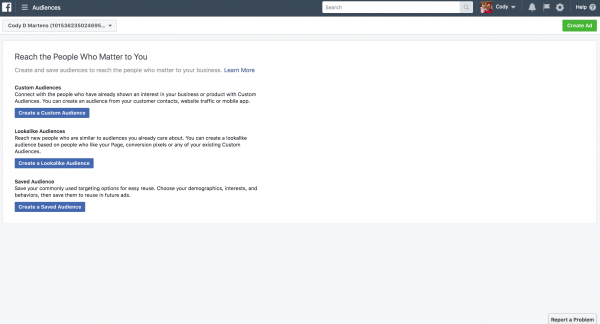
Audience Based on Demographics
The Audience Based on Demographics is all about picking characteristics or traits that fit your target client. This includes things like age, income, interests, homeownership, job status, marital status, and much, much more.
[highlight]When you select audience demographic factors, Facebook will give you a potential reach number. Use your best judgment on what is too small or too large based on your campaign goals. (More on that below.)[/highlight]
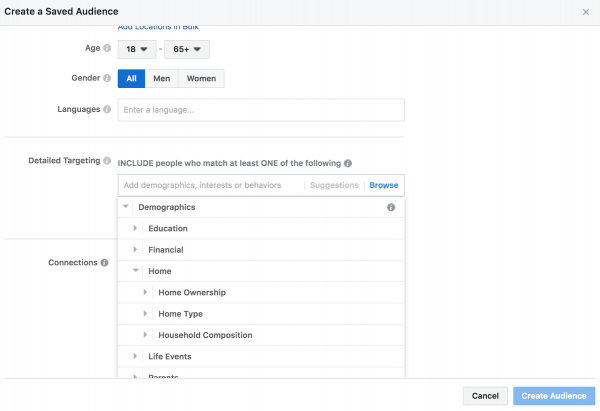
Audience Type: Saved Audience
Demographic Info: If you’re promoting your brand, you’ll want to reach anybody who might be interested in you. But if you’re promoting a refinance program, you should focus only on people who are likely to refinance soon. Here are our top choices for mortgage-related demographics:
- Locations: choose only the state/states you are licensed in OR the local area you wish to serve. Also, make sure you choose “People who live in this location” from the dropdown.
- Age: You may want to change this if you’re creating a campaign for first-time home buyers or reverse mortgages, for example.
- Detailed Targeting: This is where the fun begins.
- Demographics > Financial > Income
- Demographics > Financial > Net Worth
- Demographics > Home > (All choices)
- Demographics > Life Events > New job
- Demographics > Life Events > Newly engaged
- Demographics > Life Events > Newlywed
- Demographics > Work > Industries > (All choices)
- Behaviors > Financial > Investments > Real estate investments
- Behaviors > Purchase behavior > Home and garden > Home renovation
- Behaviors > Residential Profiles > Likely to move
[highlight]Be careful with anything in the “Interest” category under “Detailed Targeting”. Just because someone expressed an interest in something once doesn’t mean they’re a good target. For example, you could choose people interested in the military from this category, but that would include people who are and are NOT veterans.[/highlight]
When you’re first starting out, you’ll probably have to experiment to find just the right audience for what you’re offering. (This is a great A/B test for two different ad sets, by the way.)
Once you’ve found an audience that responds well to your ads, you can save that audience and use it again.
Audience Based on Website Visitors
You can tell Facebook to target visitors from your website—you can choose any number of days back, up to 180 days. You can also break it down by page or path. So, if you have certain paths on your website (say, for buying or refinancing), you can target people who have followed either path.
[highlight]This is why URL structure can be so important on your website. Make sure that all of your purchase-related pages are under a “/purchase/” URL path so you can target them all at once.[/highlight]
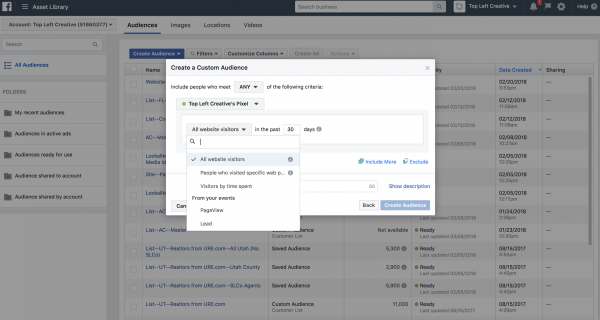
Audience Type: Custom Audience
Audience Settings: There are a few different Audiences Based on Website Visitors you can create. Here are our top choices:
- All website visitors in the past 180 days
- People who visited specific web pages in the past 60 days; URL contains “purchase”
- People who visited specific web pages in the past 60 days; URL contains “refinance”
Audience from Lists
Facebook lets you upload a list of people from offline such as your client list or an email list. It will then use information such as their name, their phone number, and their email address to match that person with their Facebook profile.
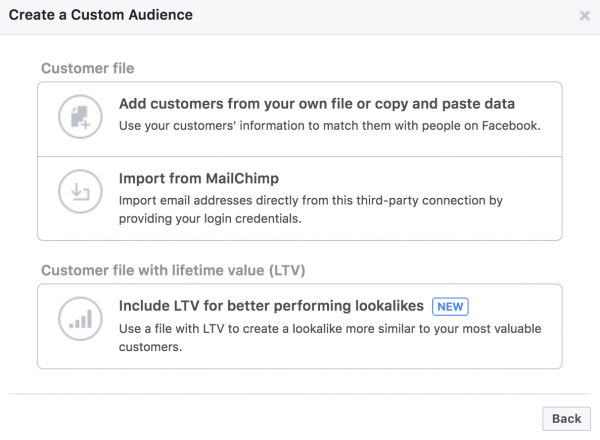
Audience Type: Custom Audience
Audience Settings: Before you upload your lists, check out this post we wrote, which includes instructions on cleaning up and segmenting your database. Here are our top choices for Audience from Lists:
- Master List: everyone in your database
- Subscribers: people who have signed up for your newsletter or requested a download on your website
- All Closed Clients
- Purchase Closed Clients (good for refinance ads!)
- Homeowners
- Renters
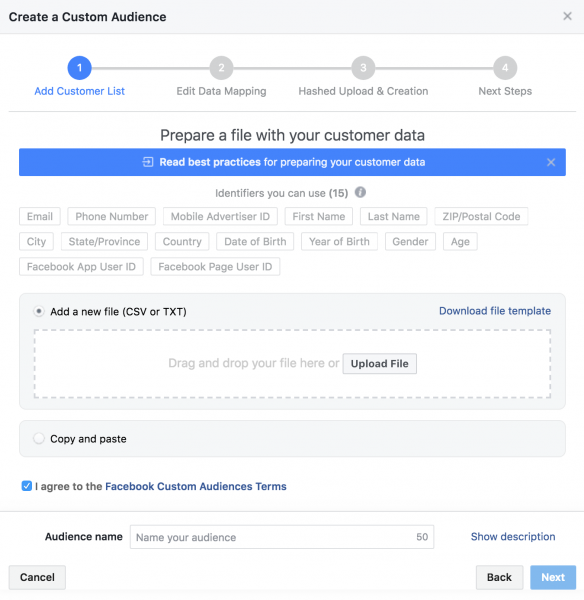
3. Set Up Three Types of Campaigns
So, we’ve established that you can’t create a Facebook ad and hope to quickly sell to people who have never heard of you (at least not a $300,000 mortgage—a $20 shirt, maybe).
Therefore, you need to create ads that reach people at each stage in the buying process. You want to move them from the awareness stage to the subscriber stage to the conversion stage. They won’t do it on their own.
Here are the three types of campaigns you need, each with a different objective. All three are crucial to your success and need to work in tandem.
Campaign #1: The Awareness Stage
For Campaign #1, we want to get as many eyeballs as possible on your content as possible as we’ll be retargeting them in your next campaign. This also gives people a chance to get to know you and start to trust you.
Goal: Traffic
Audience: For Campaign #1, we’re going to target our Audiences Based on Demographics.
It’s safe to assume that most people don’t even know who you are. So, the very first thing you need to do is make people aware of you (only people who are in your target demographic, of course).
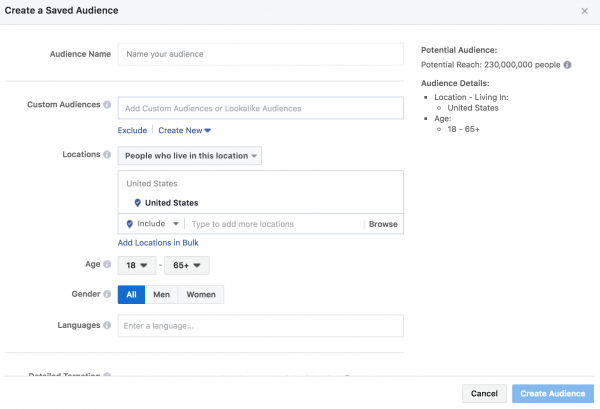
Facebook’s audience indicator will tell you if your audience is too specific, defined, or too broad based on the size of your audience and your budget.
If it’s too specific, you’ll have a hard time getting enough results. If it’s too broad, you’ll get enough, but the quality may suffer. This will be different for every audience and every goal so you’ll have to play around with it a bit.
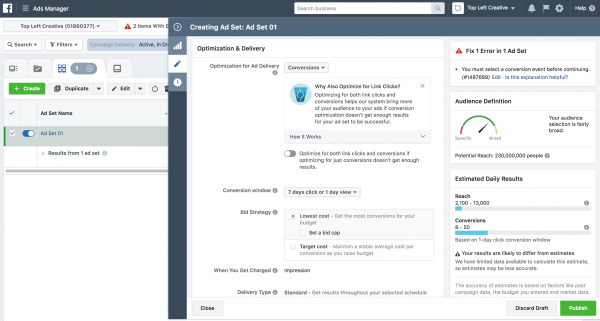
Type of Content: Hook people with clever, entertaining, useful content. You want people to go to your website. And don’t ever just send them to your home page—send them to a specific page, like a blog post.
For example, if you’re advertising a new 0% down program, you may want to send people to a blog post about it, as well as send them to other blog posts or pages on your website they may be interested in.
Budget: We recommend starting with at least $5/day, but $10/day if you can swing it.
Placement: You may want to start with Automatic Placements but, after your campaign has run for a while, check the analytics to find out which placements are performing best and turn off the others.
Optimization & Delivery: We’d recommend optimizing for Landing Page Views here.
Campaign #2: The Subscriber Stage
For Campaign #2, we’re hoping to get subscribers. When you have an email address, you know who they are and can continue to market to them. You’ll also be targeting these people again in the next campaign, giving them more chances to get to know you.
Goal: Traffic or Conversions. Test them both against each other and see which one produces better results.
Audience: For Campaign #2, we’re going to target our Audience Based on Website Visitors.
The Facebook pixel keeps track of what Facebook users do on your site and allows you to market to those people. Decide which segment of website visitors to target based on your goals. If it’s general blog content, choose everyone. If it’s for refinances, choose the audience of people who have visited your refinance path.
[highlight]Keep targeting the people in this campaign with your first campaign, as well! The more exposure, the better.[/highlight]
Type of Content: Give people gated content (which means they need to give you their email address) such as a giveaway, a download, or an email course. Your website and your product will still be fresh in their minds, and some people will be eager to get more information.
You could offer people who visited your refinance path a download with information about the seven reasons why a refinance may be right for you.
Budget: We recommend starting with at least $5–10 a day, depending on the size of your website audience.
Placement: As with Campaign #1, feel free to start with Automatic Placements at first and then change this once you have some analytics numbers to go by.
Optimization & Delivery: If you’re running a Traffic campaign, choose landing page views. If you’re running a Conversion campaign, choose Conversions.
[highlight]If you’re running a conversions campaign, tick the slider to “Optimize for both link clicks and conversions if optimizing for just conversions doesn’t get enough results.”[/highlight]
Campaign #3: The Conversion Stage
At this point, you’ve gotten people’s attention, and you’ve gotten subscribers. Now it’s time to do what you wanted to do all along—convert them into actual clients. We will now be asking them for a consultation or appointment.
Goal: Traffic or Conversions. Again, this would make a good A/B test.
Audience: For Campaign #3, we’re going to target our Audience from Lists.
Again, the list you choose will be based on the ads you’re running and the type of consultation you’re hoping to get.
[highlight]Important note: keep targeting the people in this ad set with your first two ad sets, as well! The more exposure, the better.[/highlight]
Type of Content: You’ll send people to a landing page with a form, and the sole intention of this page is to get them to give you their contact info so you can set up a consultation.
Budget: We recommend anywhere from $5–20 a day. Remember, this is the smallest size of all your lists as they’ve had to pass through campaigns #1 and #2 to get here. A small amount of money can pack more of a punch, but the cost per conversion in this campaign is MUCH higher than the cost per click in our first campaign.
Placement: As with Campaigns #1 and #2, feel free to start with Automatic Placements at first and then change this once you have some analytics numbers to go by.
Optimization & Delivery: If you’re running a Traffic campaign, choose landing page views. If you’re running a Conversion campaign, choose Conversions.
[highlight]If you’re running a conversions campaign, tick the slider to “Optimize for both link clicks and conversions if optimizing for just conversions doesn’t get enough results.”[/highlight]
4. A/B Testing
We recommend A/B testing your audiences and your ads frequently. Don’t do it every day—you want to have a big enough sample size of people who have achieved your goal before you do. Here are a few things we recommend testing against each other.
Testing Campaigns
You can test different campaign goals and see which one gives you the best results. As we hinted at above, if you’re running a Campaign #2 for the Subscriber Stage, do you get better results with a Clicks campaign or a Conversions campaign?
Testing Ad Sets
It’s important to test different audiences to see which one resonates the best with your offer. This is done at the ad set level.
For example, you may think that homeowners who are 45–55 and have an income of $125–150k would be a good audience for a refinance, but it could be homeowners who are 35–45 and have an income of $75–$125k.
You won’t know until you A/B test these two audiences against each other and see which one performs better.
[highlight]One important thing to note is that Facebook tries very hard to automatically optimize campaigns, ad sets, and ads for you to produce the best results. Some of these things are better left to Facebook to optimize.[/highlight]
[highlight]Another important note: if you are running two ad sets with the same audience selected in both, you’re essentially bidding against yourself.[/highlight]
Testing Ads
You should also test your Facebook ads against each other so you can see what works best and improve all of your ads. When we split test ads, we always start with different images and use the same text, and then choose the winning image and add new headlines, and so on.
[highlight]It’s important you only A/B test one thing at a time or you won’t know what change made the difference.[/highlight]
Recommended Reading:
5. Analytics
Here are the numbers that matter for the campaigns we just described.
Campaign #1: Number of unique clicks to the landing page, cost per unique click (should be as low as possible)
Campaign #2: Number of unique clicks to the landing page, number of unique conversions (downloads)
Campaign #3: Number of unique conversions (how many people actually set up a consultation with you)
However, it’s very important to note that these numbers may not be totally accurate, which is why you need to keep track of metrics in your CRM.
Someone may call you because they saw your Facebook ad instead of filling out the form. This is why it’s critical that you ask all leads how they found you every single time.
Recommended Reading
6. Landing Pages
A final key component of a great mortgage Facebook ads campaign is having a great landing page.
First, make sure that your landing page mimics the ad that people just clicked from. You don’t want someone to be intrigued by an ad, click to your landing page, and then be completely confused about how the two relate to each other. There’s no quicker way to turn someone off.
Using the same headline in the ad and landing page is a pro move. Feel free to create as many landing pages as you need.
Recommended Reading:
Here are some more resources for creating the perfect landing page:
- Must-have Tips for Writing a Landing Page
- Remarkable Landing Pages (with Examples)
- 5 Stages of Writing Landing Page Copy
- How to Create an Effective Landing Page
Securing Your Site
An SSL certificate provides a secure connection to your page, which means that any information people give you is safe. This is something you need to do when setting up a landing page.
Recommended Reading:
Need More Help?
We haven’t covered the nitty gritty of actually creating the Facebook campaigns, ad sets, and ads themselves. There are many solid guides out there, and here are a few of them.
- Hubspot’s Step-by-Step Guide to Facebook Advertising
- Hootsuite’s Complete Guide to Advertising on Facebook
Ready to Start Your Own Campaign?
We hope this helps you get started on your own mortgage Facebook ads campaign. If you take the time to set it up right and are diligent about following through, we think you’ll be impressed with the results.


Leave a Reply